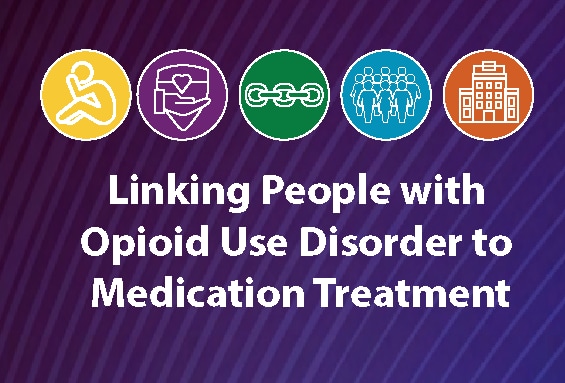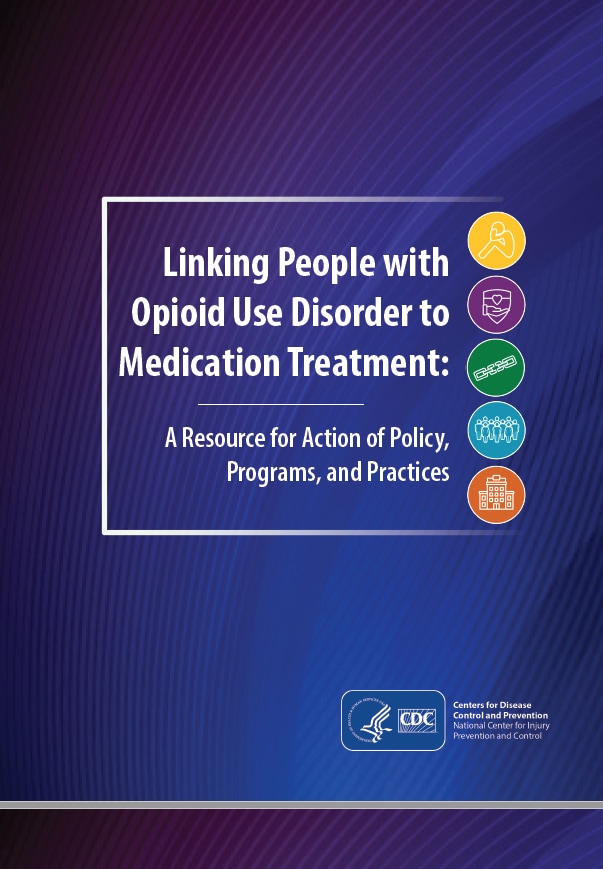Linking People with Opioid Use Disorder to Medication Treatment
A Resource for Action of Policy, Programs, and Practices

Millions of Americans are living with opioid use disorder (OUD). Fortunately, medications for opioid use disorder (MOUD), such as methadone, buprenorphine, and naltrexone, can effectively treat OUD, reduce illicit opioid use or prescription opioid misuse, and lower the risk of opioid-related harms, including transmission of viral hepatitis and HIV, overdose, and death.
Health care professionals and community leaders in public health, education, criminal justice, social services, business, and government all have a role to play in increasing access and linkage to MOUD. This Linking People with Opioid Use Disorder to Medication Treatment [PDF – 48 pages] document offers guidance and evidence-based strategies to support linkage to care for each sector.
This resource for action [PDF – 48 pages] describes linkage to evidence-based care for opioid use disorder. This resource has five sections:
- Introduction and overview
- The cascade of care for opioid use disorder
- Opportunities for linkage to care
- Best practices across populations
- Barriers and facilitators of treatment access
Linkage to Care Best Practices by Care Setting
Implementation strategies described in this document focus on creating accessible, equitable, sustainable, and culturally competent approaches to linking people living with OUD to evidence-based care. Commitment, cooperation, and leadership from numerous sectors, including public health, education, criminal justice, health care, social services, business, labor, and government are key to successful implementation.
As healthcare professionals who form long-term relationships with many of their patients, primary care providers may be positioned to earn the trust of patients in ways that other specialists or short-term care providers are not. Further, that long-term relationship positions these clinicians to provide long-term support for chronic conditions, including OUD. Primary care can improve opportunities for linkage to care when:
- The primary care setting is welcoming, nonjudgmental, respectful, and empathetic.1
- Screening for OUD is universal: All patients receiving services from a primary care practice are screened for opioid use using a validated screening tool, not tested through urine or blood toxicology.1
- Patients reporting polysubstance use, previous substance use treatment, or co-occurring mental disorders are assessed to determine whether higher levels of treatment or more substantial support in treatment engagement are needed.2,3
- Medical issues often associated with opioid use or other substance use (including infectious, renal, hepatic, and cardiovascular concerns) are recognized and followed with screening, assessment, and appropriate care.1
- Patients at higher risk are identified, trained to respond to overdose, and provided with naloxone.4,5
- MOUD, when indicated, is provided at the visit when OUD is identified, and patients begin induction onto MOUD immediately6 or, in the case of home induction, as soon as reasonably possible.7–9
- Ongoing MOUD is integrated into primary care rather than offered through referral to a specialist or outside facility.10,11
Screening for OUD in emergency departments (ED) may identify patients who could benefit from MOUD who would not be screened elsewhere or do not have access to other services EDs can improve opportunities for linkage to care when:
- The ED setting is welcoming, nonjudgmental, respectful, and empathetic.1
- Referral to community care is conducted through a warm handoff (a transfer in care that is completed in person in front of the patient and, when appropriate, the patient’s family).12
- Patients at higher risk are identified, trained to respond to overdose, and provided with naloxone prior to discharge.13
- A trained peer recovery coach is available to consult with the patient if desired.14
Clinicians and support staff providing care to inpatients have extended close contact with patients. People living with OUD who are admitted to inpatient care can be offered medically supervised detoxification to alleviate their withdrawal symptoms, creating an opportunity to discuss and initiate long-term MOUD. Teams providing care to inpatients can improve opportunities for linkage to care when:
- The hospital setting is welcoming, nonjudgmental, respectful, and empathetic.1
- Complex financial and systems needs associated with large hospitals are integrated into planning and implementing improved linkage-to-care services.15
- Patients with OUD are screened to assess risk behaviors and addiction severity so they can be triaged into the level of care appropriate for them.16
- Any intervention provided to the inpatient is followed by continued MOUD after discharge, as short-term medically supervised detoxification, or medically supervised withdrawal, is strongly associated with return to substance use.17
- Patients at higher risk are identified, trained to respond to overdose, and provided with naloxone prior to discharge.13
Linkage to MOUD from a syringe service program (SSP) may take various forms, including warm handoffs to partnering MOUD prescribers with ongoing patient navigation or peer support; co-located (or closely located) SSP and MOUD services; and integrated SSP and MOUD care with onsite medication induction and continuation of care. SSPs can improve opportunities for linkage to care when:
- The SSP setting is welcoming, nonjudgmental, respectful, and empathetic.1
- SSP staff and volunteers can build meaningful and trusting relationships with participants over time.18
- Effective case management is provided to facilitate linkage and entry into treatment.19
- SSP participants have access to qualified health insurance plans and are supported in initiating and completing enrollment.20
- Linkage to care is bundled with linkage to other services that alleviate common barriers to treatment success, including housing support and transportation assistance.19,21
- The basic operation of SSPs (especially providing access to sterile injection equipment, most clients’ primary incentive for visiting the SSP22) is unencumbered by drug paraphernalia laws that criminalize possession of harm reduction supplies,23–25 insufficient funding,26 intrusive or intimidating police presence,27,28 one-for-one mandates or other limits on syringe distribution,24 or other restrictions that limit the program’s ability to meet participants needs.
Prenatal and postpartum healthcare professionals may offer wrap-around care for pregnant people through a collaborative care model that brings together care related to pregnancy, birth, and OUD in a single setting. Teams providing prenatal and postpartum care can improve opportunities for linkage to care when:
- The prenatal and postpartum care settings are welcoming, nonjudgmental, respectful, and empathetic.1
- Screening for substance use disorders with a validated tool is universal for all pregnant people seeking prenatal care—beginning at the first prenatal visit.29
- Care is approached through nonpunitive means and when the patient doesn’t feel at risk of legal repercussions (including the involvement of child protective services and the risk of forcible removal of their children30) for disclosing substance use during pregnancy.31
- Care is delivered through a collaborative care model with supportive providers (e.g., clinicians, counselors, social workers, patient navigators) working in tandem.32,33
- Pregnant patients with OUD are not forced to withdraw from opioids34 but are instead maintained on opioid agonist medications, preferably buprenorphine/naloxone if acceptable to the patient.31 Methadone is a safe option if the patient desires.35
Mental health professionals are in a unique position to link patients with OUD to MOUD while treating mental health co-morbidities that may be associated with substance use. Teams providing mental and behavioral health care can improve opportunities for linkage to care when:
- The mental and behavioral health setting is welcoming, nonjudgmental, respectful, and empathetic.1
- Treatment services for OUD and other mental disorders are integrated and co-located.36
- Services for co-occurring mental disorders are established prior to the initiation of treatment for OUD.37

Linking persons with OUD to evidence-based treatment while they are incarcerated or under community supervision reduces illicit drug use, overdose risk, and rates of drug-related crime and increases engagement with other essential forms of health care. Linkage to care in health care settings during incarceration and community supervision works best when:
- The health care setting during incarceration and pre-release procedures are welcoming, nonjudgmental, respectful, and empathetic.1
- Treatment with MOUD is uninterrupted for those receiving care prior to incarceration.38
- MOUD can be initiated in criminal justice settings.39
- Persons have access to all FDA-approved MOUD. This choice is essential, as some people fare much better (or worse) on one of these drugs than on the others.40
- Dosages of opioid agonist MOUD are not restricted. For example, methadone dosages in excess of 60 mg are needed to retain patients in treatment and to generate reduction in illicit opioid use in community care settings.41 Evidence does not support using lower dosages in incarcerated settings.
- An effective system for referral and linkage to care is in place so that persons on MOUD can receive a warm handoff to providers who can continue their care, without interruption, upon release.42
- MOUD is offered with evidence-based psychosocial counseling; however, according to SAMHSA’s best practices for providing MOUD in criminal justice settings, no justification exists for denying access to MOUD because psychosocial services are unavailable or because someone is unwilling to engage in those services.43
- Community practitioners who provide MOUD meet with people who are incarcerated prior to their release to assess health care and social support need to ensure a smooth transition to community care, which should begin immediately upon release.43
See the full list of strategies in CDC’s Resource for Action for Linking People with Opioid Use Disorder to Medication Treatment [PDF – 48 pages].
- Medications for Opioid Use Disorder (MOUD) Study
- Opioid Rapid Response Program (ORRP)
- Overdose Data to Action (OD2A)
- Evidence-Based Strategies for Preventing Opioid Overdose
- Promising State Strategies and Partnerships
- Prescription Drug Monitoring Program (PDMP)
- Substance Use During Pregnancy
- Opioids Use During Pregnancy
- CDC Vital Sign: Life Saving Naloxone from Pharmacies
- Infectious Diseases, Opioids, and Injection Drug Use
- Annual Surveillance Report of Drug-Related Risks and Outcomes (2019) [PDF]
- Substance Abuse and Mental Health Services Administration. Medication for Opioid Use Disorder. Substance Abuse and Mental Health Services Administration; 2018. Accessed December 28, 2019. https://store.samhsa.gov/system/files/sma18-5063fulldoc.pdf
- Simon CB, Tsui JI, Merrill JO, Adwell A, Tamru E, Klein JW. Linking patients with buprenorphine treatment in primary care: Predictors of engagement. Drug Alcohol Depend. 2017;181:58-62. doi:10.1016/j.drugalcdep.2017.09.017
- Najt P, Fusar-Poli P, Brambilla P. Co-occurring mental and substance abuse disorders: A review on the potential predictors and clinical outcomes. Psychiatry Research. 2011;186(2):159-164. doi:10.1016/j.psychres.2010.07.042
- Raffel KE, Beach LY, Lin J, et al. Naloxone Distribution and Training for Patients with High-Risk Opioid Use in a Veterans Affairs Community-Based Primary Care Clinic. Perm J. 2018;22. doi:10.7812/TPP/17-179
- Guy GP, Haegerich TM, Evans ME, Losby JL, Young R, Jones CM. Vital Signs: Pharmacy-Based Naloxone Dispensing – United States, 2012-2018. MMWR – Morbidity & Mortality Weekly Report. 2019;68(31):679-686.
- Bernstein SL, D’Onofrio G. Screening, treatment initiation, and referral for substance use disorders. Addiction Science & Clinical Practice. 2017;12(1):18. doi:10.1186/s13722-017-0083-z
- Srivastava A, Kahan M, Leece P, McAndrew A. Buprenorphine unobserved “home” induction: a survey of Ontario’s addiction physicians. Addiction Science & Clinical Practice. 2019;14(1):18. doi:10.1186/s13722-019-0146-4
- Walley AY, Alperen JK, Cheng DM, et al. Office-based management of opioid dependence with buprenorphine: clinical practices and barriers. J Gen Intern Med. 2008;23(9):1393-1398. doi:10.1007/s11606-008-0686-x
- Kermack A, Flannery M, Tofighi B, McNeely J, Lee JD. Buprenorphine prescribing practice trends and attitudes among New York providers. Journal of Substance Abuse Treatment. 2017;74:1-6. doi:10.1016/j.jsat.2016.10.005
- Gourevitch MN, Chatterji P, Deb N, Schoenbaum EE, Turner BJ. On-site medical care in methadone maintenance: associations with health care use and expenditures. J Subst Abuse Treat. 2007;32(2):143-151. doi:10.1016/j.jsat.2006.07.008
- Weinstein ZM, Kim HW, Cheng DM, et al. Long-term retention in Office Based Opioid Treatment with buprenorphine. J Subst Abuse Treat. 2017;74:65-70. doi:10.1016/j.jsat.2016.12.010
- Boudreaux ED, Haskins B, Harralson T, Bernstein E. The Remote Brief Intervention and Referral to Treatment Model: Development, Functionality, Acceptability, and Feasibility. Drug Alcohol Depend. 2015;155:236-242. doi:10.1016/j.drugalcdep.2015.07.014
- Gunn AH, Smothers ZPW, Schramm-Sapyta N, Freiermuth CE, MacEachern M, Muzyk AJ. The Emergency Department as an Opportunity for Naloxone Distribution. West J Emerg Med. 2018;19(6):1036-1042. doi:10.5811/westjem.2018.8.38829
- Samuels EA, Baird J, Yang ES, Mello MJ. Adoption and Utilization of an Emergency Department Naloxone Distribution and Peer Recovery Coach Consultation Program. Acad Emerg Med. 2019;26(2):160-173. doi:10.1111/acem.13545
- Englander H, Weimer M, Solotaroff R, et al. Planning and Designing the Improving Addiction Care Team (IMPACT) for Hospitalized Adults with Substance Use Disorder. J Hosp Med. 2017;12(5):339-342. doi:10.12788/jhm.2736
- Cushman PA, Liebschutz JM, Anderson BJ, Moreau MR, Stein MD. Buprenorphine Initiation and Linkage to Outpatient Buprenorphine do not Reduce Frequency of Injection Opiate Use Following Hospitalization. J Subst Abuse Treat. 2016;68:68-73. doi:10.1016/j.jsat.2016.06.003
- Nunes EV, Gordon M, Friedmann PD, et al. Relapse to opioid use disorder after inpatient treatment: Protective effect of injection naltrexone. J Subst Abuse Treat. 2018;85:49-55. doi:10.1016/j.jsat.2017.04.016
- Latkin CA, Davey MA, Hua W. Needle exchange program utilization and entry into drug user treatment: is there a long-term connection in Baltimore, Maryland? Subst Use Misuse. 2006;41(14):1991-2001. doi:10.1080/10826080601026027
- Strathdee SA, Ricketts EP, Huettner S, et al. Facilitating entry into drug treatment among injection drug users referred from a needle exchange program: Results from a community-based behavioral intervention trial. Drug Alcohol Depend. 2006;83(3):225-232. doi:10.1016/j.drugalcdep.2005.11.015
- Strathdee SA, Celentano DD, Shah N, et al. Needle-exchange attendance and health care utilization promote entry into detoxification. J Urban Health. 1999;76(4):448-460. doi:10.1007/BF02351502
- Havens JR, Latkin CA, Pu M, et al. Predictors of opiate agonist treatment retention among injection drug users referred from a needle exchange program. J Subst Abuse Treat. 2009;36(3):306-312. doi:10.1016/j.jsat.2008.07.002
- Kral AH, Anderson R, Flynn NM, Bluthenthal RN. Injection risk behaviors among clients of syringe exchange programs with different syringe dispensation policies. J Acquir Immune Defic Syndr. 2004;37(2):1307-1312.
- Rich JD, Adashi EY. Ideological Anachronism Involving Needle and Syringe Exchange Programs: Lessons From the Indiana HIV Outbreak. JAMA. 2015;314(1):23-24. doi:10.1001/jama.2015.6303
- Bluthenthal RN, Kral AH, Erringer EA, Edlin BR. Drug Paraphernalia Laws and Injection-Related Infectious Disease Risk among Drug Injectors. Journal of Drug Issues. 1999;29(1):1-16. doi:10.1177/002204269902900101
- Davis CS, Carr DH, Samuels EA. Paraphernalia Laws, Criminalizing Possession and Distribution of Items Used to Consume Illicit Drugs, and Injection-Related Harm. American Journal of Public Health. 2019;109(11):1564-1567.
- Nguyen TQ, Weir BW, Des Jarlais DC, Pinkerton SD, Holtgrave DR. Syringe Exchange in the United States: A National Level Economic Evaluation of Hypothetical Increases in Investment. AIDS Behav. 2014;18(11):2144-2155. doi:10.1007/s10461-014-0789-9
- Davis CS, Burris S, Kraut-Becher J, Lynch KG, Metzger D. Effects of an Intensive Street-Level Police Intervention on Syringe Exchange Program Use in Philadelphia, Pa. Am J Public Health. 2005;95(2):233-236. doi:10.2105/AJPH.2003.033563
- Carroll JJ. Auras of Detection: Power and Knowledge in Drug Prohibition. Contemporary Drug Problems. 2021;48(4):327-345. doi:10.1177/00914509211035487
- Committee on Obstetric Practice. Committee Opinion No. 711: Opioid Use and Opioid Use Disorder in Pregnancy. Obstet Gynecol. 2017;130(2):e81-e94. doi:10.1097/AOG.0000000000002235
- Terplan M, Minkoff H. Neonatal Abstinence Syndrome and Ethical Approaches to the Identification of Pregnant Women Who Use Drugs. Obstet Gynecol. 2017;129(1):164-167. doi:10.1097/AOG.0000000000001781
- Angelotta C, Weiss CJ, Angelotta JW, Friedman RA. A Moral or Medical Problem? The Relationship between Legal Penalties and Treatment Practices for Opioid Use Disorders in Pregnant Women. Womens Health Issues. 2016;26(6):595-601. doi:10.1016/j.whi.2016.09.002
- Howard H. Experiences of opioid-dependent women in their prenatal and postpartum care: Implications for social workers in health care. Soc Work Health Care. 2016;55(1):61-85. doi:10.1080/00981389.2015.1078427
- Mittal L, Suzuki J. Feasibility of collaborative care treatment of opioid use disorders with buprenorphine during pregnancy. Subst Abus. 2017;38(3):261-264. doi:10.1080/08897077.2015.1129525
- ACOG Committee on Health Care for Underserved Women, American Society of Addiction Medicine. ACOG Committee Opinion No. 524: Opioid abuse, dependence, and addiction in pregnancy. Obstet Gynecol. 2012;119(5):1070-1076. doi:10.1097/AOG.0b013e318256496e
- Saia KA, Schiff D, Wachman EM, et al. Caring for Pregnant Women with Opioid Use Disorder in the USA: Expanding and Improving Treatment. Curr Obstet Gynecol Rep. 2016;5(3):257-263. doi:10.1007/s13669-016-0168-9
- Zaller N, Gillani FS, Rich JD. A model of integrated primary care for HIV-positive patients with underlying substance use and mental illness. AIDS Care. 2007;19(9):1128-1133. doi:10.1080/09540120701335196
- King VL, Brooner RK, Peirce J, Kolodner K, Kidorf M. Challenges and outcomes of parallel care for patients with co-occurring psychiatric disorder in methadone maintenance treatment. J Dual Diagn. 2014;10(2):60-67. doi:10.1080/15504263.2014.906132
- Aronowitz SV, Laurent J. Screaming Behind a Door: The Experiences of Individuals Incarcerated Without Medication-Assisted Treatment. J Correct Health Care. 2016;22(2):98-108. doi:10.1177/1078345816634079
- Brinkley-Rubinstein L, Cloud DH, Davis C, et al. Addressing excess risk of overdose among recently incarcerated people in the USA: harm reduction interventions in correctional settings. Int J Prison Health. 2017;13(1):25-31. doi:10.1108/IJPH-08-2016-0039
- Connery HS. Medication-assisted treatment of opioid use disorder: review of the evidence and future directions. Harv Rev Psychiatry. 2015;23(2):63-75. doi:10.1097/HRP.0000000000000075
- Brady TM, Salvucci S, Sverdlov LS, et al. Methadone dosage and retention: an examination of the 60 mg/day threshold. J Addict Dis. 2005;24(3):23-47. doi:10.1300/J069v24n03_03
- Prendergast ML, Hall EA, Grossman J, et al. Effectiveness of Using Incentives to Improve Parolee Admission and Attendance in Community Addiction Treatment. Crim Justice Behav. 2015;42(10):1008-1031. doi:10.1177/0093854815592914
- Substance Abuse and Mental Health Services Administration. Use of Medication-Assisted Treatment for Opioid Use Disorder in Criminal Justice Settings. Substance Abuse and Mental Health Services Administration (US); 2019. Accessed July 22, 2019. https://store.samhsa.gov/system/files/guide_4-0712_final_-_section_508_compliant.pdf


